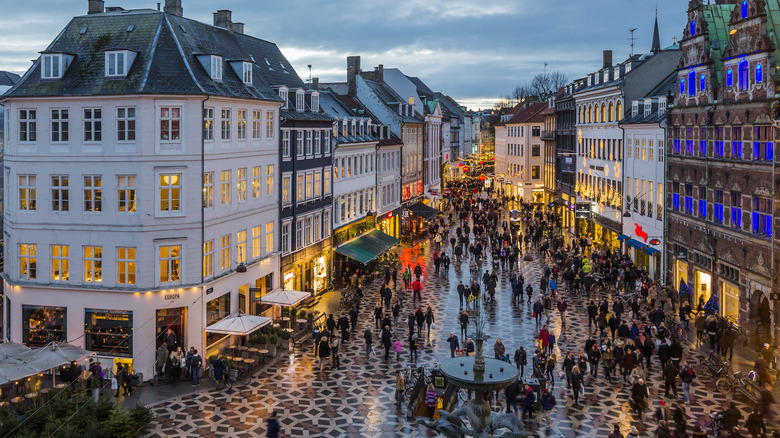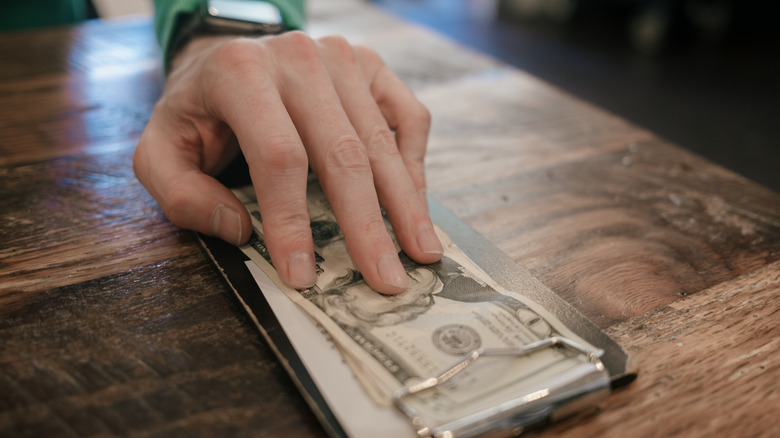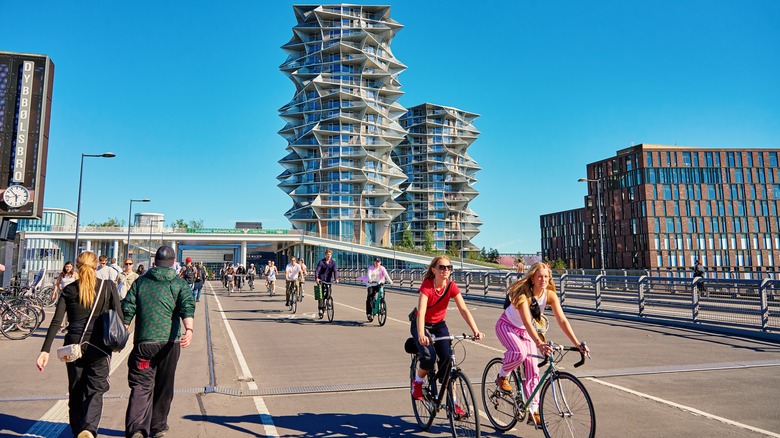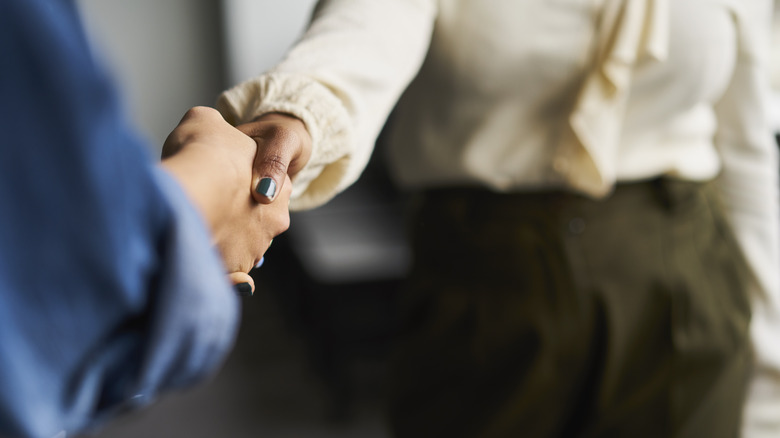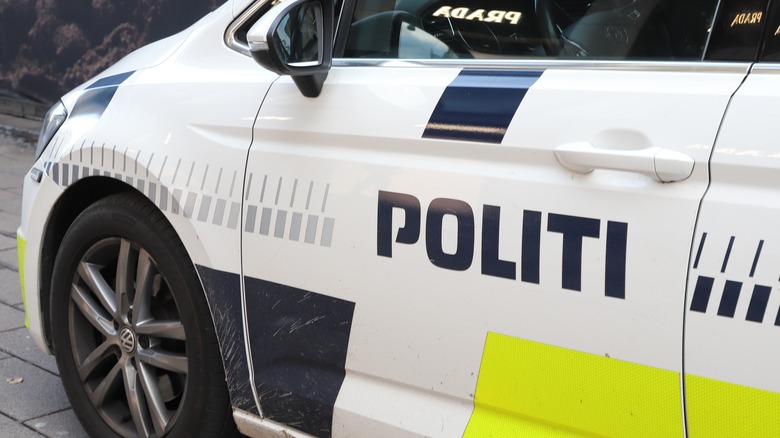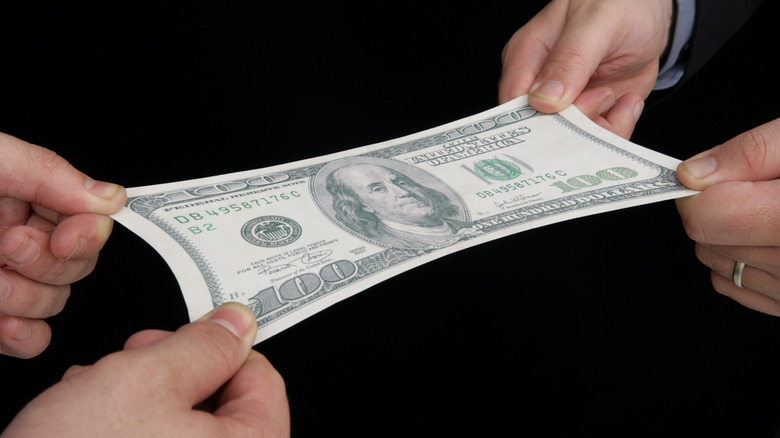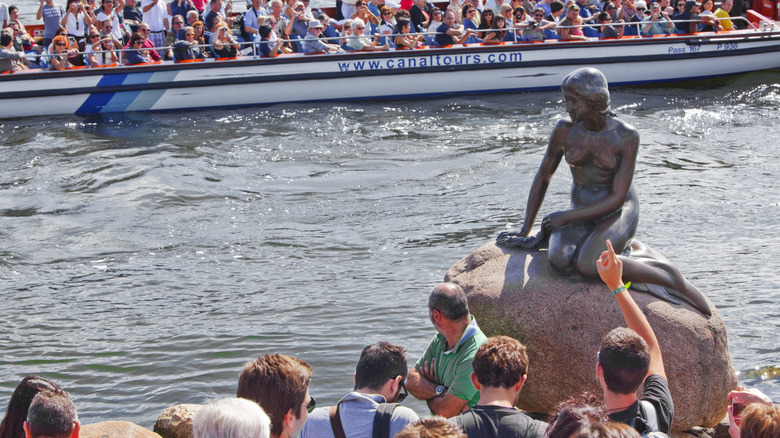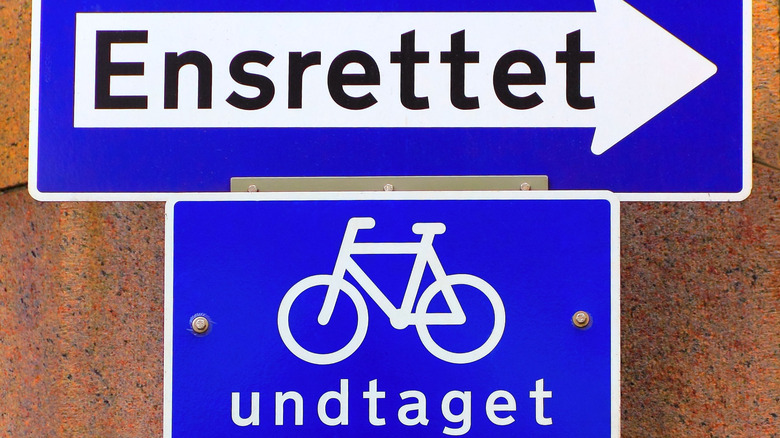Etiquette Rules And Other Crucial Things To Know Before You Visit Copenhagen
Copenhagen's reputation as one of Europe's premier city-break locations has been on the rise of late. There are, after all, compelling reasons to visit. It's home to Noma, the five-time winner of the prestigious Best Restaurant in the World title. It's a place of unique experiences; Troll hunts and city-harbor swimming are just some of the more unusual activities you can enjoy during the summer months. It's a pedestrian-friendly place — topographically flat and easy to navigate by bicycle — and its underground rail network spans the entire metro area, offering a cheap and convenient way to see the sights. And that's just for starters.
In the summer and spring, you can visit the oldest theme park in the world or take a stroll through the world-famous Tivoli Gardens — which just so happens to contain the second oldest theme park. As the nights draw in, you can dabble in a bit of noctourism — a phenomenon where travelers actively seek darker skies to catch a glimpse of the northern lights or other astronomical events. Or, spend some time wandering around one of the best Christmas markets in Europe. Still, for all its ease of access, accessibility, and well-established things-to-do lists, there remain pitfalls to watch out for. There are tourist traps to avoid in Copenhagen, etiquette to adhere to, and rules and regulations that you need to get to grips with to get the most out of your stay. Here, then, are some of the most important things to bear in mind during a trip to Copenhagen.
Always use a knife and fork
The simultaneous use of knives and forks has been a feature of European culture since the mid-16th century. However, it wasn't until the third middle prong was introduced in the early 1700s that it became a fully functional tool. Indeed, the design is intuitive enough that most grasp the basics with little or no instruction. Foregoing the use of a knife when tackling a bowl of pasta is somewhat intuitive. Dual-wielding as you tuck into a steak comes naturally. And sure, salads, at times, require a little introspection when it comes to selecting cutlery. Eating salad at a French restaurant is a legitimate minefield, and for the most part, people know where they stand.
Then there are those items that fit into the "definitely not" category. Pizza is a finger food, and sandwiches were developed as a way to eat freely without pesky implements. Fries are for grabbing, Hot dogs for clutching, and all manner of wings, nuggets, shellfish, and kebabs have been a hands-free affair since their inception — unless you're in Denmark. Any food lover's guide to Copenhagen takes time to highlight culinary delights to investigate while exploring the city. Generally, less effort is taken to formalize the rules of dining itself.
Danish people use knives and forks for everything. Well, OK, not everything; soup is eaten with a spoon or sometimes drunk out of a mug — the Danish propensity for cutlery is a national idiosyncrasy, not an irrational obsession. Nevertheless, the list of things the Danes like to cut into small pieces before consuming is conspicuously long. Pizzerias are alive with the chink of metal on porcelain. Smørrebrød, Denmark's iconic open-faced sandwich, is to be dissected, savored, and placed delicately in the mouth.
Tipping
Tipping is so ingrained in American culture that it often comes as a surprise that other nations shy away from adding a little extra on top of the presented bill. Indeed, there are places in the world where tipping is considered rude. The Japanese don't care for the practice; it's one of those things tourists in Japan should never do. In certain parts of provincial China, the practice is so frowned upon that it might be against the law. Elsewhere, especially across Europe, the service charge is included in the final bill. In other cases, tips are entirely at the customer's discretion; they are welcomed if offered but never expected. Denmark falls into this latter category.
This lackadaisical approach to gratuities stems from the relatively high wages service staff can expect to receive in Denmark. In the U.S., the basic wage for people who receive tips is $2.13 an hour. Although Denmark has no specific minimum wage, the average monthly take-home pay for service staff sits at around $3,000 and, in some cases, reaches over twice that figure. In Copenhagen, then, tips are more of a bonus than a matter of survival. If you feel that the service was particularly good, leaving a 10% gratuity is sufficient to signal your approval. The only exception here is taxis. In Denmark, as in many other places, not rounding up to the nearest note and thus forcing an exchange of coins is considered bad form.
How to get around the city
There are four basic ways to explore the city of Copenhagen: You can hire a car, hop on the Metro, explore on foot, or rent a bicycle. Taxis are also available, but they are costly and best used sparingly, if at all. Adventurous souls can also rent a Kayak for free in Copenhagen. This is highly recommended, though there are some obvious limitations when using it as a principal form of locomotion.
Unless you are planning to explore some of the surrounding regions, hiring a car for a city break is not recommended. Copenhagen is one of the least congested cities in Scandinavia and offers easier and cheaper ways to get about. North American visitors will also be relieved that its motorists drive on the right-hand side of the road. The Metro serves visitors from the moment they arrive; it's only a 15-minute ride from Kastrup airport to the center of the city.
The Copenhagen card provides access to over 80 attractions and allows free access to public transport. It's an excellent option for those who prefer a hectic pace and want to cram as much as possible into their stay. Thriftier travelers might want to adopt an ad hoc approach to their metro use; when interspersed with a series of brisk, tactical walks, the savings are often substantial. Copenhagen is, however, very much a city of bikes. While not to everyone's taste, hiring a bicycle is one of the best ways to explore the city. The city's hop-on-hop-off Donkey Bikes are available 24/7 via the Donkey Republic app. You can also visit any number of shops that are happy to offer a longer-term rental at a reasonable price.
Meeting and greeting
Part of the joy of travel stems from the opportunity to meet locals and share fresh perspectives on life with them. Of course, it's important to remember that every nation is entitled to idiosyncrasies. While stereotyping is never a good thing, legitimate national characteristics exist and should be observed and respected. In Copenhagen, for example, punctuality is a must — more on that later — but recognizing personal space is also paramount.
Danish people don't like to be touched; indeed, Scandinavians, in general, tend to be less than effervescent when meeting new people. Most reserve hugging and kissing for close friends and family; some shy away from even that. Acquaintances are most likely to be greeted with a firm handshake. Public displays of affection are not frowned upon per se but are less of a common sight than you would find elsewhere.
Such formality extends to naming conventions. You might find that Danes use your given name and surname during formal introductions and may continue to do so until they get to know you better, which may take a surprising amount of time. Linguistically, Danes tend to be quite direct. Pretty much everyone you meet in Copenhagen speaks English, and questioning their ability to do so is one sure way to irritate a resident. Expect a lot of eye contact and short, curt sentences. You should also enjoy the dry, understated humor that Scandinavians are so well known for.
Staying safe on your journey
Safety should always be at the forefront of planning a vacation. Whether you are trying to avoid Australia's most dangerous wildlife, attempting to honor travel advisory warnings in the Caribbean, or just looking for a little peace of mind, it pays dividends to do research before setting off. For those intending to visit Copenhagen, there isn't much to worry about. The Economist Intelligence Unit has voted the Danish capital the safest city in the world since 2016.
However, when people think of safety, their mind often turns to crime. Thankfully, Denmark has a low crime rate and ranks among the most peaceful countries in the world. But that's not all. Copenhagen impresses with potable tap water. Its waterways are so clean that locals can often be seen fishing in them. The road network is well-maintained, although the high number of cyclists means that drivers have to keep their wits about them at all times. Car accidents are rare, and the weather is more or less predictable outside of the depths of winter.
If any emergency occurs, dial 112. As with most people in Copenhagen, the operators and responders will all have a firm grasp of English. If you need the police for a non-emergency situation, the number to dial is 114, and such calls are free from public phones. If you need to visit a hospital's ER, call (+45) 1813 to let them know to expect you.
How to stretch your budget
As delightful as a trip to Copenhagen often is, one aspect of a visit to the Danish capital rubs people the wrong way — the price. A meal at a mid-range restaurant is likely to set you back around $60 per person. A cappuccino costs around $7. An imported beer has been creeping toward the $10 mark for some time now. Still, there are ways of keeping costs down. The previously mentioned Copenhagen card is not cheap, but it does allow you near carte-blanche access to all that the city has to offer. There are also some under-the-radar Denmark destinations that are every bit as exciting as Copenhagen. Many of them cater to locals and, as such, avoid the price hike generally found at touristy hotspots.
Lastly, indulging in any of the many free attractions on offer helps stretch that budget. In sunny weather, for example, you can hang out at one of the city's many parks — Ørstedparken comes highly recommended. If it's raining, wander around the impressive central library with its mix of old-world reading rooms and exquisite modern designs. The Ny Carlsberg Glyptotek — Copenhagen's art and sculpture museum — is another hidden gem that does not charge an entrance fee. You can also use some standard ways to save money. Bikes are cheap; taxis are not, and restaurants and vendors close to tourist hotspots — looking at you, Nyhavn – charge a premium for their services.
Punctuality is a must
The Danish obsession with punctuality is a well-documented phenomenon. Copenhagen, as a city, adheres to a strict timetable. Trains arrive on time, and on those occasions when they are late, you can apply for a refund. Business events take place on the dot, and rigid schedules are adhered to. Time is even allocated to idle chit-chat prior to the start of the meeting, so the leisurely activity does not seep into official time. Dinner reservations are held to the same standard as most social functions.
This rigidity of schedules means that Danish people sometimes lack spontaneity. As a rule, they turn up on time for work and social commitments and expect others to do likewise. If you are held up for any reason, a phone call to explain the cause of your tardiness is essential if you wish to avoid offense. For this reason, asking a Dane to meet you for dinner invariably leads to a quick calendar check to make sure it doesn't clash with any other meeting.
In a similar vein, although meals often last several hours in the Danish capital, once they are done, they are done. If a Copenhagen resident says they need to leave at any given time, you can rest assured they mean what they say. Abrupt ends to social gatherings are definitely a thing; in such cases, no offense is intended, so none should be taken. Work-life balance is especially important, and most Danes go home to spend time with their family at the end of the working day. Businesses have to pay overtime if they want workers to stay behind after hours, and excessive after-hour activity is frowned upon.
Avoid tourist traps
Generally speaking, major cities are littered with things to see and do. In some cases, such locations live up to expectations. In others, they are hubs of overpriced disappointment destined to leave a blemish on an otherwise delightful vacation. Copenhagen is no exception to this rule. Take Nyhaven, for example. A former commercial port, this stretch of waterfront property serves as a draw for tourists who gravitate towards its brightly colored taverns and quaint architectural promise. A former den of iniquity — the area used to serve visiting sailors and was notorious for its brothels. Today, it is filled with pushy street vendors and overpriced bars, restaurants, and taverns.
Meanwhile, "The little Mermaid" statue manages to disappoint in tangential ways. Constructed in 1911 to memorialize Copenhagen alumni Hans Christian Andersson's famous story, it remained a fairly minor point of interest for most of its life. That changed in 1989 after Disney released an animated film of the same name. It soon became a focal point of visitors to the city and remains so to this day. Unfortunately, the statue is only 4 feet tall, situated on a narrow rocky outcrop, and queues to get a picture of yourself standing next to it can wind around the region for hours.
Other traps abound. There are overpriced canal boat rides to avoid, main shopping streets to steer clear of, and rip-off tourist venues that locals would not touch with a barge pole. Crowds and hawkers are a great indicator that you have landed in such a region. At any rate, finding the real Copenhagen down the narrow back streets is generally more fulfilling than marching up and down the endless thoroughfares that channel tourists to the next pricey attraction.
Know the rules; follow the rules
Like any other country, Denmark has a list of dos and don'ts, some of which make sense to wandering travelers and others that lead, on occasion, to bouts of furious head-scratching. No-brainers abound. Refraining from walking on cycle paths is, for example, of immense benefit to those wishing to avoid hospital bills. DUI stops are often carried out randomly, and any driver found to be under the influence will spend some time in jail. Possession of small quantities of marijuana carries instant fine penalties – anything more substantial will land you in prison for sure.
Other less prosaic rules should also be taken into consideration. Nude sunbathing is permitted but only in designated areas. Few Danish people own firearms, and a license is required for those who wish to carry; needless to say, such permits are not issued to tourists. The country is LGBTQ+ friendly, and its generally liberal attitude means that the police have a light touch when it comes to most minor incidents. Still, in cases where you notice signs indicating you should refrain from a given activity — such as walking on the grass or taking photographs in restricted areas — it's best to follow the rule. Danish people do not react well to those who openly flaunt convention, as anyone who has tried to queue-hop in Copenhagen can attest to.
How to blend in
It's no secret that tourists tend to stick out like a sore thumb, and in many cases, the desire to appear unobtrusive is linked to fears of victimization. However, Copenhagen's reputation as one of the safest cities in the world means that visitors often look for other reasons to blend in during their vacation. One such reason rises above all others: Copenhagen just so happens to be one of the happiest places in the world.
Part of the explanation for such contentment stems from the Danish concept of hygge, a word that roughly translates to "coziness" but contains far more nuance than "cozy" could ever convey. Cuddling up with a loved one, spending time with friends in the park, enjoying a mug of cocoa on a winter's evening? It's all hygge to the Danes. Visitors can experience this feeling without hearing the word. Shops and restaurants pay service to hygge via mood lighting, customer service, wafted scents, and crackling fires. Outside, locals often plan events and meet-ups with hygge in mind. And if that's all too subtle for you, there's always the opportunity to join a hygge tour. Such curated guides take you through the best happiness spot the city has to offer at a relaxing — some might say cozy — pace.
Meanwhile, wearing Scandinavian designs and weather-appropriate attire can help you experience life in the city without drawing too much attention. Danish people tend to dress well at all times, so a trip to Copenhagen might require a wardrobe refresh, a proactive desire to leave your comfy pants at home, or a shopping spree on arrival. Just stay clear of the "I love Copenhagen" T-shirts.
